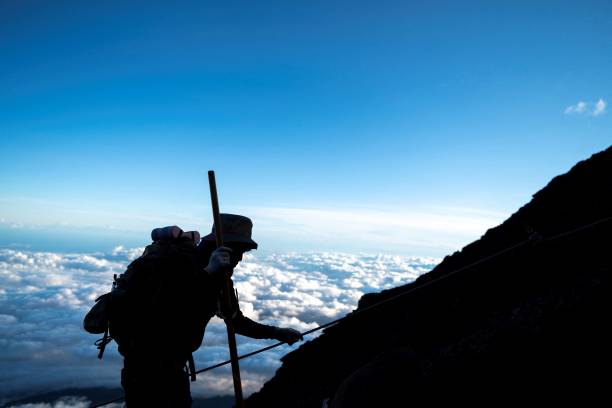
A man hiking to the summit of Mount Fuji, some 70 kilometres (43 miles) west of the capital Tokyo. CHARLY TRIBALLEAU/AFP via Getty Images.
Oldest Person to Climb Mount Fuji Achieves Historic Record
Kokichi Akuzawa, born in 1923, reached the summit of Mount Fuji in early August after years of steady preparation and disciplined training.
He climbed the 3,776-metre (12,388-foot) peak despite a serious heart condition that might have discouraged others from attempting such a feat.
The achievement surpassed the previous known verified ascent by a 96-year-old, placing Akuzawa six years ahead of the earlier benchmark.
He said that the climb was part of his routine, emphasising that he had been climbing mountains almost every week for decades.
“I am six years older than the last time I climbed,” Akuzawa told Agence France-Presse, recalling his earlier successful summit at the age of 96.
Guinness World Records Recognises Oldest Person to Climb Mount Fuji
Guinness World Records confirmed the certification after reviewing evidence provided by Akuzawa’s team and mountain officials who witnessed the climb.
The organisation highlighted the extraordinary rarity of the accomplishment, given the risks associated with extreme altitude for centenarians.
It acknowledged the climb as proof of resilience and perseverance, qualities often celebrated in Guinness listings worldwide.
Officials described the documentation as comprehensive, with both video and photographic evidence presented for verification.
The certification drew widespread media attention, reinforcing the symbolic weight of the achievement in a country known for longevity.
Training and Preparation Behind Oldest Person to Climb Mount Fuji
Akuzawa credited decades of weekly mountain climbing for building the stamina and strength necessary to endure Mount Fuji’s demanding slopes.
He explained that he never approached training as extraordinary but as a consistent habit that shaped his endurance over many years.
Japanese commentators observed that his preparation reflected a disciplined approach common among the nation’s centenarians.
Medical professionals noted that sustained physical activity contributes significantly to reducing the risks of severe aging-related decline.
His case has been cited as an example of how structured physical activity extends beyond fitness into maintaining confidence and mental strength.
Global Interest in Oldest Person to Climb Mount Fuji
The news of Akuzawa’s climb quickly spread internationally, resonating as both a sporting accomplishment and a human interest story.
Mount Fuji, which was added to the World Heritage list in 2013, continues to draw climbers as a cultural and spiritual challenge.
Officials estimate that more than 300,000 people attempt the climb every year, though many younger climbers struggle with the mountain’s altitude.
Akuzawa’s success contrasted with the difficulties faced by much younger individuals, intensifying the symbolic weight of his record.
Reports highlighted that while the physical feat is remarkable, it also reflects deep cultural values of perseverance embedded in Japanese society.
Aging and Endurance Highlighted by Oldest Person to Climb Mount Fuji
The record has reignited global discussions on aging populations and how physical activity contributes to healthy longevity.
Japan has one of the fastest-aging societies, with more than 90,000 centenarians currently recorded by government health authorities.
Public health officials frequently stress the importance of physical activity in helping older people remain independent and engaged.
Akuzawa’s climb was seen as an example of how consistent movement may mitigate the effects of chronic illness, even with heart conditions.
Scholars studying aging pointed to his achievement as symbolic evidence of how traditional exercise practices continue to support Japan’s reputation for longevity.
A Symbol of Strength for Japan’s Aging Society
Akuzawa’s success story became part of broader conversations about how older generations remain vital within modern societies.
Commentators noted that his achievement was not merely personal but collective, demonstrating that age need not be a barrier to aspiration.
Some analysts argued that stories like his inspire not only Japan but other nations facing similar demographic challenges.
The record was framed as an encouragement to adopt healthier lifestyles at all ages, especially in communities struggling with sedentary habits.
Observers stressed that such achievements also serve as a reminder of the resilience possible in later stages of life.
Inspiration Drawn from Oldest Person to Climb Mount Fuji
Akuzawa’s modest remarks stood in contrast with the global praise directed at him for his Guinness World Records recognition.
“I just did what I always do,” he said, underscoring that consistency rather than spectacle defined his journey to the summit.
His humility highlighted the difference between public celebration and personal perception, reminding many that routine often fuels greatness.
Related: Glastonbury Festival 2025: Your Full Guide to This Year’s Biggest Music Event
The image of a centenarian at Mount Fuji’s peak has since been shared widely as a symbol of hope and determination.
His achievement continues to inspire younger climbers, older citizens, and policymakers seeking examples of active aging in practice.

